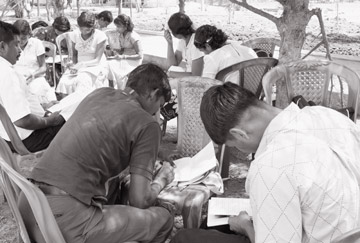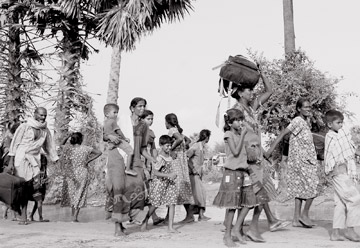|
Less than 25,000 remain in camps:
Bulk of displaced persons return home
By Dhaneshi YATAWARA
|

Young boys and girls engaged in their studies
|
As at September 19, 2010 official records state that 24,355 people
are remaining at the Cheddikulam and Jaffna welfare camps. Yet almost
one year and four months ago the figure was staggering. As recorded by
the Ministry of Resettlement on May 30, 2009 in Vavuniya, 262,629
Internally Displaced Persons were sheltered in 25 welfare centres while
11,164 were living in six welfare centres in Jaffna. Two welfare centres
in Mannar shelter 1,362 IDPs. The government had anticipated this exodus
and was prepared to deal with it.
During the last few days of the Eelam War IV, thousands of people
reached the safety of the Sri Lanka Army, fleeing away from the LTTE. By
May 18-19, 2009 nearly 85,000 IDPs reached the Cheddikulam Menik Farm
Welfare camp. The LTTE herded the people of Vanni into a rapidly
shrinking enclave in Mullaitivu as part of their military strategy and
then used them as human shield. History repeated itself. During the
battle of Vakarai in the East the LTTE held 34,000 easterners as a human
shield. Despite adverse international comments and misinformation Sri
Lanka methodically weakened the terrorist group, One time described by
the Federal Bureau of Investigation (FBI) as being “the most dangerous
and deadly extremists in the world”, and set about eliminating it.
Thousands streamed out of the LTTE’s final stronghold when the security
forces broke through.
Winning the war was an unparalleled achievement which Sri Lanka was
able to do convincingly on its own under President Mahinda Rajapaksa.
The grand finale was overwhelmingly convincing compared with the efforts
by larger and better equipped forces thousands of miles from their own
borders, to counter terrorist threats. The victory generated great
confidence in the hearts and minds of the people. Following the
silencing of guns the stock market records started moving upward and
investment flow over the months increased while inflation dipped to an
all time low. Rupee maintained its value and foreign currency reserves
showed a sharp increase. Positive indications multiplied.
Slowly but steadily, the blanket of fear that engulfed the country
for nearly three decades was, being removed. The success of the security
forces and Sri Lanka’s diplomacy, has also aroused significant
admiration around the world.
UN figures indicate that 26 million are currently displaced the world
over, including in Asia, some directly caused by external interventions.
250,000 were displaced in Pakistan in the latter part of 2009. Many of
the displaced around the world have remained in squalid camps for many
years. Terrorist groups remain a threat elsewhere in the world despite
the deployment of more sophisticated forces, advanced equipment. Deaths
and injury and the large scale displacement of civilians in other places
still continue.

A group of IDPs
Pic : Rukmal Gamage |
With all the remarkable achievements, Sri Lankans responded with an
outpouring of support to the Government during the series of Provincial
Council Elections in 2008, 2009 and the Presidential Elections in 2010.
No Government in the history has ever enjoyed so much of popular support
in their tenures. Today the Government’s effort is to convert this
political confidence to sustainable peace and economic activities. Sri
Lanka has undergone a string of catastrophic experiences resulting in
thousands of persons being displaced in recent years with significant
consequence on the economy. And this will be a daunting task. Dealing
with the aftermath of the tsunami and winning the war required a range
of complex tactical approaches. Much of Sri Lanka’s success in dealing
with the tsunami was due to its well developed health services sector
and the caring nature and generosity of Sri Lankans. Tempted to compare
ourselves with the rest of the world, we see displaced people from
Hurricane Katrina were not yet resettled. Few weeks back, commemorating
the devastation US President Barack Obama blamed the Government
administration of the state for this failure. Much poorer, less
sophisticated, yet we are more fortunate.
Today, almost everyone who was displaced by the tsunami has returned
home. Some returned to better homes in specially constructed housing
schemes almost within three years. Much of the business activity has
resumed and tourism in the affected areas has been revived.
The anticipated epidemics as feared during natural disasters, did not
happen in Sri Lanka. People did not languish in camps longer than
necessary. Hardly a sign remains to remind the world of the devastation.
Similarly, most of the persons displaced in the Eastern Province have
now been returned to their homes. They have successfully re-established
themselves in their villages and towns. It was mainly through
Government’s own effort. Abandoned villages are getting reconstructed;
the roads and irrigation works are rehabilitated. Village schools and
clinics are getting restored. The economic progress of the province has
been impressive. Last but not least the democratic processes were
re-established in the Eastern Province following the 2007 elections.
The welfare villages which provided shelter, food, healthcare,
education and security to the IDPs will soon be history. They were the
focus of international concern for months but security concerns were far
more important. Sri Lanka suffered brutal terrorism nearly three decades
and was too fragile to take too many risks though there was mammoth
sized anticipation from the international arena on alleged human right
violations. All these encounters were in the process of caring to a
group of our own citizens facing devastation who were once a bargaining
chip for the LTTE in their deadly hostage game.
Every effort has been made to ensure that the temporary stay of the
displaced was as comfortable as possible. The IDP camps also provided
banking and postal facilities. In a welcome development, the banks
received close to Rs 400 million in deposits in the space of two days in
June 2009. Since then the major banks have reopened branches in Jaffna
and other Northern towns and are doing a brisk business.
This clearly demonstrated that many in the camps had significant
financial resources. Some obviously carried their money and gold
carefully with them and managed to keep it away from the LTTE. This is
in stark contrast to the IDPs who have poured in to camps elsewhere in
the world. It also indicates that the displaced had confidence in Sri
Lanka’s banking system.
The government has been working on enhancing this feeling of
confidence. Today the return of all the IDPs to their own homes and the
restoring economic activities is priority.
To cater to a mammoth number of IDPs it costs millions of dollars per
day. For a country seeking a growth in the economy this expenditure is a
massive burden.
Therefore, their return to their own homes was always central to the
thinking of Government plan.
The displaced returned to their homes at the rate of 1500 - 2000
every day. The roads, destroyed during 30 years of fighting need to be
repaired in the resettling villages. The irrigation works need to be
restored. All of which will require massive investments.
As the IDPs return to their homes, a serious challenge continues to
be posed by unmapped LTTE mine fields in the North. The Government
estimates that there are over 402 Sq. km. of mine fields to be cleared.
Over 1.5 million mines had been laid. Many villages have been demined,
largely by the Army. 29 demining machines were obtained, mainly from the
Czech Republic with assistance from UNHCR and Australia. Assistance was
also provided by the UN, India, Japan, Norway, the UK, the US, etc. 70%
of the demining has been achieved by the Sri Lankan Army.
For over twenty seven years, due to a conflict which was not of its
own making, Sri Lanka’s resources remained under-utilized. With more
lands coming under cultivation the rural economy’s contribution to the
national economy accelerated. The progress was evident in the marked
increase in the GDP percentage. Today Sri Lanka enjoys a growth of 8.5%.
President Rajapaksa Government plans to increase the per capita income
up to US$ 4000.
It is the intention of the government to ensure that what is taken
for granted elsewhere in Sri Lanka by way of democratic governance is
available in the North also and that the grievances of all our people
are addressed through democratic mechanism.
As President Mahinda Rajapaksa said on 19th May 2009 “Ending
terrorism in Sri Lanka means a victory for democracy in the world. Sri
Lanka has now given a beginning to the ending of terrorism in the
world.”
President Mahinda Rajapaksa has repeatedly invited Sri Lankan Tamils
around the world to return to their homeland and become parties to the
nation building effort.
As reconstruction and reconciliation became a priority, the
Government has clearly stated that it is determined to reach out to all
its friends and even to its former critics as it sets about with the
task of nation building.
Sri Lanka is at a critical juncture in its history. Sri Lanka has a
unique opportunity to bring its people together and make the blessed
island a better place for all in a world where power structures and
economic strength have undergone dramatic changes. |

